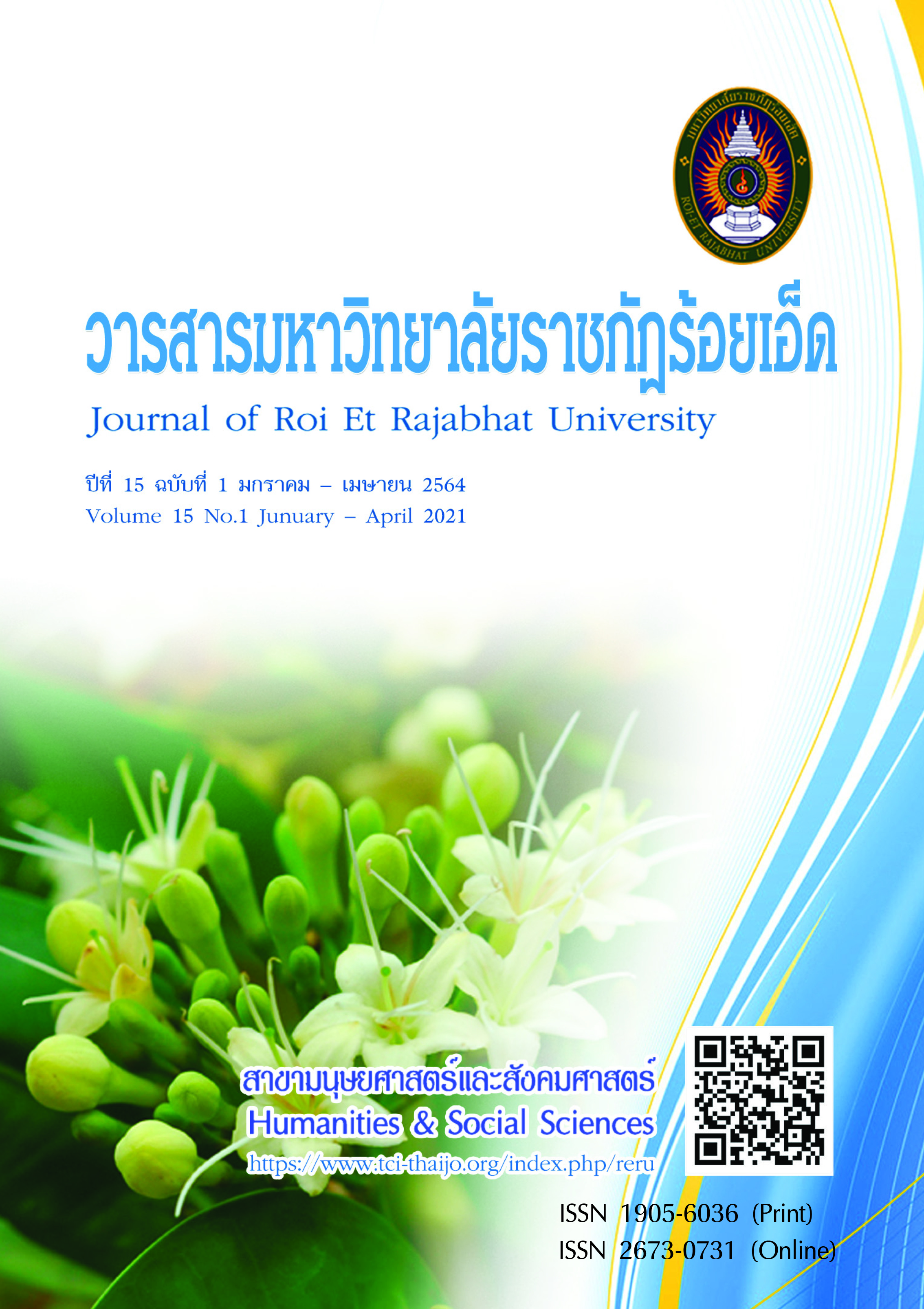A Casual Relationship Model of Selected Factors Affecting Effectiveness of Secondary Schools in the Northeastern Part of Thailand
Keywords:
Causal relationship model, Secondary school effectiveness, Organizational cultureAbstract
The purposes of this research were: 1) to study selected factors affecting the effectiveness of secondary schools in the Northeast, 2) to examine the causal relationship between the developed model of selected factors affecting the effectiveness of secondary schools In the Northeast with the empirical data, and 3) to obtain guidelines for developing the selected factors that affected the effectiveness of secondary schools in the Northeast. The sample consisted of 640 secondary schools in the Northeast under the Office of the Basic Education Commission, academic year 2018. The research methodology were divided into 3 phases: Phase 1 construct the hypothesis model, Phase 2 examine tool validation, Phase 3, discover the guidelines for developing selected factors. The tools used for data collection were a questionnaire and an interview form. Statistics used for data analysis were percentage, mean, standard deviation, skewness, kurtosis, Pearson's coefficient and the analysis of structural equation modeling. The research found that 1) The constructed causal relationship model of selected factors affecting the effectiveness of secondary schools in the Northeast consisted of casual variables including; transcendental leadership, organizational culture, learning process management and the innovative organization 2) The constructed causal relationship model of selected factors affecting the effectiveness of secondary schools in the Northeast, the model was congruent with the empirical data. 3) Guidelines for development of selected factors that preform direct effect were as follows: (1) transcendental leadership, (2) learning process management and (3) innovative organization and a selected factor that contained direct and indirect effects is the organizational culture.
References
คณะอนุกรรมการการปฏิรูปการเรียนรู้. (2544). ปฏิรูปการเรียนรู้ ผู้เรียนสำคัญที่สุด. กรุงเทพฯ: สำนักงานคณะกรรมการการศึกษาแห่งชาติ.
จตุรภัทร ประทุม. (2559). ปัจจัยที่ส่งผลต่อประสิทธิผลของสถานศึกษา สังกัดสำนักงานเขตพื้นที่การศึกษามัธยมศึกษา เขต 27. ดุษฎีนิพนธ์ ปรัชญาดุษฎีบัณฑิต สาขาวิชาบริหารการศึกษาชลบุรี: มหาวิทยาลัยบูรพา.
ชนาธิป พรกุล. (2554). การสอนกระบวนการคิด ทฤษฎีและการนำไปใช้. กรุงเทพฯ: สำนักพิมพ์จุฬาลงกรณ์มหาวิทยาลัย.
ดวงกมล อินทา. (2556). วัฒนธรรมองค์การ. สืบค้นเมื่อ 22 เมษายน 2562, จาก http://duangss.blogspot.com/2013/09/blog-post_12.html
ธวัชชัย ตั้งอุทัยเรือง. (2557). โมเดลความสัมพันธ์เชิงสาเหตุของประสิทธิผลของโรงเรียน สังกัดสำนักงานคณะกรรมการการศึกษาขั้นพื้นฐานในภาคกลาง ประเทศไทย. ดุษฎีนิพนธ์ ปรัชญาดุษฎีบัณฑิต สาขาวิชาบริหารการศึกษา กรุงเทพฯ: มหาวิทยาลัยคริสเตียน.
นงลักษณ์ วิรัชชัย. (2548). สถิติชวนใช้. กรุงเทพฯ: จุฬาลงกรณ์หาวิทยาลัย.
วัฒนชัย ศิริญาณ, วิทยา เจริญศิร และสัญญา เคณาภูมิ. (2560). องค์กรแห่งนวัตกรรม: ทางเลือกใหม่สำหรับการพัฒนาในศตวรรษที่ 21. ดุษฎีนิพนธ์ ปรัชญาดุษฎีบัณฑิต สาขาวิชาบริหารการศึกษา. มหาสารคาม: มหาวิทยาลัยราชภัฏมหาสารคาม.
วิจารณ์ พานิช. (2555). วิถีสร้างการเรียนรู้เพื่อศิษย์ ในศตวรรษที่ 21. กรุงเทพฯ: มูลนิธิ สดศรี-สฤษดิ์วงศ์.
สมาพร ภูวิจิตร. (2558). รูปแบบวัฒนธรรมองค์กรที่มีประสิทธิภาพ.วารสารวิทยาลัยนครราชสีมา สาขามนุษยศาสตร์และสังคมศาสตร์, 9(1), 73-77.
สุเทพ พงศ์ศรีวัฒน์. (2561). ภาวะผู้นำแบบเหนือชั้น. สืบค้นเมื่อ 22 เมษายน 2561, จาก http://suthep.crru.ac.th/
สำนักงานคณะกรรมการการศึกษาขั้นพื้นฐาน. (2561). ระบบสารสนเทศเพื่อบริหารการศึกษา. สืบค้นเมื่อ 22 เมษายน 2562, จาก http://data.bopp-obec.info/emis/school.php.
สำนักแผนและประกันคุณภาพการศึกษา. (2558). แนวทางการดำเนินงานด้านการเรียนการสอนในศตวรรษที่ 21. กรุงเทพฯ: สำนักแผนและประกันคุณภาพการศึกษา.
อมรา ไชยดำ และ วิชิต กำมันตะคุณ. (2559). ประสิทธิผลของสถานศึกษาในสังกัดสำนักงานเขตพื้นที่การศึกษามัธยมศึกษา เขต 27. วารสารบัณฑิตศึกษา, 13(61), 209-224.
อำรุง จันทวานิช. (2547). แนวทางการบริหารและการพัฒนาสถานศึกษาสู่โรงเรียนคุณภาพ. กรุงเทพฯ: พริกหวานกราฟฟิค.
Coombs, J. (1991). Thinking seriously about curriculum integration (Forum on Curricular Integration Occasional Paper no. 4). Burnaby, BC: Simon Fraser University, Tri-University Integration Project.
Drucker, P.F. (2007). Management Challenges for the 21st Century. New York: Butterworth-Heinemann.
Grisay, A. & Mahlek, L. (1991). The Quality of Education in Developing Countries. A Review of Some Research Studies and Policy Documents. UNESCO: IIEP.
Hismanoglu, M. (2012). The impact of globalization and information technology on language education policy in Turkey. Procedia: Social and Behavioral Sciences.
Hoy, W.K. and Miskel, C.G. (2005). Educational Administration: Theory, Research, and Practice (7thed.). New Yourk: McGraw Hill.
McGregor, A.J. (2008). Adolescents expectancy beliefs and task values for physically interactive video games. Los Angeles: Louisiana State University.
Downloads
Published
How to Cite
Issue
Section
License
บทความที่ได้รับการตีพิมพ์เป็นลิขสิทธิ์ของวารสารมหาวิทยาลัยราชภัฎร้อยเอ็ด
ข้อความที่ปรากฏในบทความแต่ละเรื่องในวารสารวิชาการเล่มนี้เป็นความคิดเห็นส่วนตัวของผู้เขียนแต่ละท่านไม่เกี่ยวข้องกับมหาวิทยาลัยราชภัฎร้อยเอ็ด และคณาจารย์ท่านอื่นๆในมหาวิทยาลัยฯ แต่อย่างใด ความรับผิดชอบองค์ประกอบทั้งหมดของบทความแต่ละเรื่องเป็นของผู้เขียนแต่ละท่าน หากมีความผิดพลาดใดๆ ผู้เขียนแต่ละท่านจะรับผิดชอบบทความของตนเองแต่ผู้เดียว





